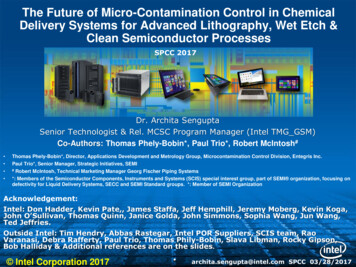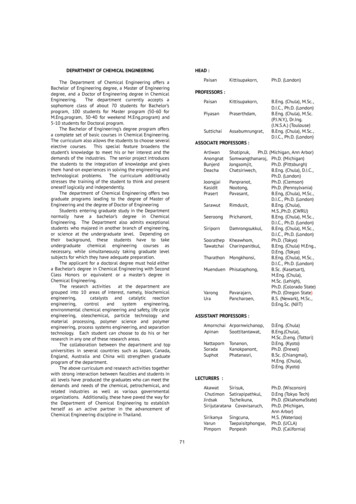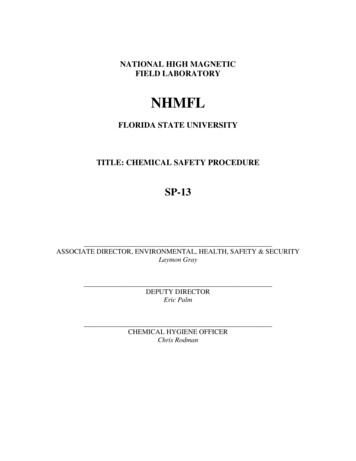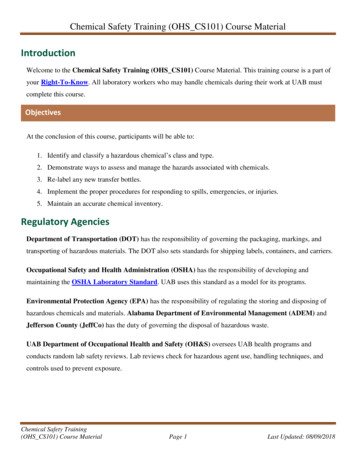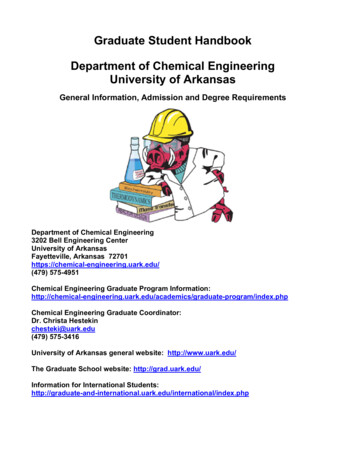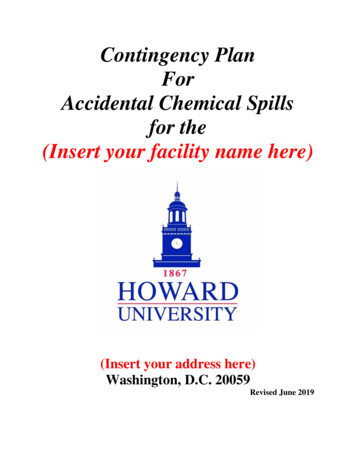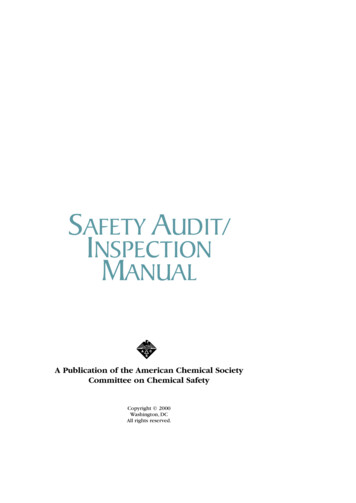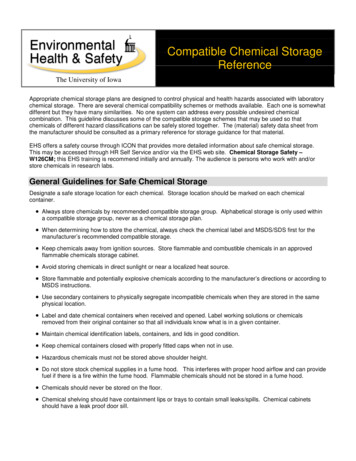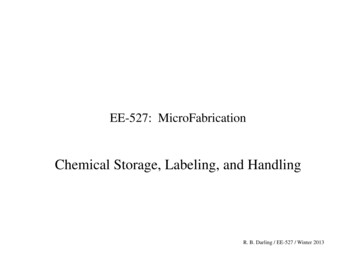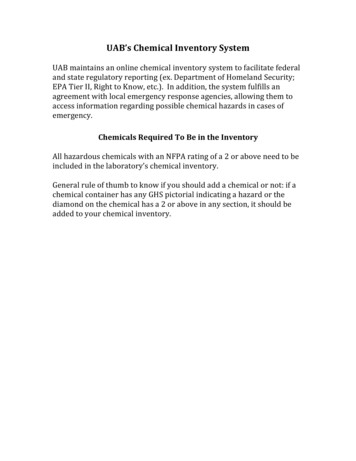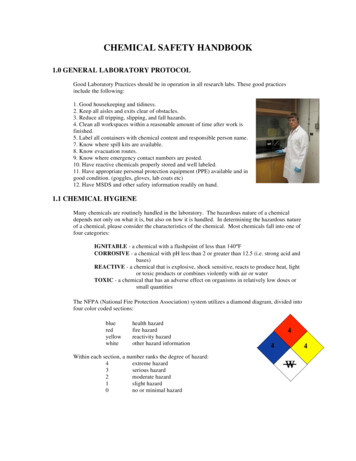
Transcription
CHEMICAL SAFETY HANDBOOK1.0 GENERAL LABORATORY PROTOCOLGood Laboratory Practices should be in operation in all research labs. These good practicesinclude the following:1. Good housekeeping and tidiness.2. Keep all aisles and exits clear of obstacles.3. Reduce all tripping, slipping, and fall hazards.4. Clean all workspaces within a reasonable amount of time after work isfinished.5. Label all containers with chemical content and responsible person name.7. Know where spill kits are available.8. Know evacuation routes.9. Know where emergency contact numbers are posted.10. Have reactive chemicals properly stored and well labeled.11. Have appropriate personal protection equipment (PPE) available and ingood condition. (goggles, gloves, lab coats etc)12. Have MSDS and other safety information readily on hand.1.1 CHEMICAL HYGIENEMany chemicals are routinely handled in the laboratory. The hazardous nature of a chemicaldepends not only on what it is, but also on how it is handled. In determining the hazardous natureof a chemical, please consider the characteristics of the chemical. Most chemicals fall into one offour categories:IGNITABLE - a chemical with a flashpoint of less than 140 FCORROSIVE - a chemical with pH less than 2 or greater than 12.5 (i.e. strong acid andbases)REACTIVE - a chemical that is explosive, shock sensitive, reacts to produce heat, lightor toxic products or combines violently with air or waterTOXIC - a chemical that has an adverse effect on organisms in relatively low doses orsmall quantitiesThe NFPA (National Fire Protection Association) system utilizes a diamond diagram, divided intofour color coded sections:blueredyellowwhitehealth hazardfire hazardreactivity hazardother hazard informationWithin each section, a number ranks the degree of hazard:4extreme hazard3serious hazard2moderate hazard1slight hazard0no or minimal hazard
The white section alerts the user to special hazards the material may possess, such as:water reactivitystrong oxidizer Oxcorrosivityradioactivity.PoisonExamples:
1.2 MIXING CHEMICALSWATERACIDCHEMICALMixing of chemicals can lead to dangerousconditions such as the release of toxic gases,release of flammable gases, violent heatingand splattering, or explosive reactions. Beforemixing any chemicals, refer to a chemicalincompatibility list (such as the one below)and the chemicals' MSDS's. Some examplesthat could occur with chemicals common tothe ERC are the mixing of nitric acid andmethanol waste, which will result in anexplosive mixture, or adding water toconcentrated acid which is very exothermicand will result in splattering of the corrosiveacid. Do not mix any chemicals unless youknow it is safe! Be aware of what is in awaste bottle before disposing of your wasteand label the waste properly.INCOMPATIBLE CHEMICAL(S)Acetic acidaldehyde, bases, carbonates, hydroxides, metals, oxidizers, peroxides,phosphates, xyleneAcetylenehalogens (chlorine, fluorine, etc.), mercury, potassium, oxidizers, silverAcetoneacids, amines, oxidizers, plasticsAlkali and alkaline earthmetalsacids, chromium, ethylene, halogens, hydrogen, mercury, nitrogen,oxidizers, plastics, sodium chloride, sulfurAmmoniaacids, aldehydes, amides, halogens, heavy metals, oxidizers, plastics,sulfurAmmonium nitrateacids, alkalis, chloride salts, combustible materials, metals, organicmaterials, phosphorous, reducing agents, ureaAnilineacids, aluminum, dibenzoyl peroxide, oxidizers, plasticsAzidesacids, heavy metals, oxidizersBromineacetaldehyde, alcohols, alkalis, amines, combustible materials, ethylene,fluorine, hydrogen, ketones (acetone, carbonyls, etc.), metals, sulfurCalcium oxideacids, ethanol, fluorine, organic materialsCarbon (activated)alkali metals, calcium hypochlorite, halogens, oxidizersCarbon tetrachloridebenzoyl peroxide, ethylene, fluorine, metals, oxygen, plastics, silanesChloratespowdered metals, sulfur, finely divided organic or combustible materialsChromic acidacetone, alcohols, alkalis, ammonia, basesChromium trioxidebenzene, combustible materials, hydrocarbons, metals, organic materials,phosphorous, plasticsChlorinealcohol's, ammonia, benzene, combustible materials, flammablecompounds (hydrazine), hydrocarbons (acetylene, ethylene, etc.),hydrogen peroxide, iodine, metals, nitrogen, oxygen, sodium hydroxideChlorine dioxidehydrogen, mercury, organic materials, phosphorous, potassium hydroxide,sulfur
Coppercalcium, hydrocarbons, oxidizersHydroperoxidereducing agentsCyanidesacids, alkaloids, aluminum, iodine, oxidizers, strong basesFlammable liquidsammonium nitrate, chromic acid, hydrogen peroxide, nitric acid, sodiumperoxide, halogensFluorinealcohol's, aldehydes, ammonia, combustible materials, halocarbons,halogens, hydrocarbons, ketones, metals, organic acidsHydrocarbons (Such asbutane, propane benzene,turpentine, etc.)acids, bases, oxidizers, plasticsHydrofluoric acidmetals, organic materials, plastics, silica (glass), (anhydrous) sodiumHydrogen peroxideacetylaldehyde, acetic acid, acetone, alcohol's carboxylic acid,combustible materials, metals, nitric acid, organic compounds,phosphorous, sulfuric acid, sodium, anilineHydrogen sulfideacetylaldehyde, metals, oxidizers, sodiumHypochloritesacids, activated carbonIodineacetylaldehyde, acetylene, ammonia, metals, sodiumMercuryacetylene, aluminum, amines, ammonia, calcium, fulminic acid, lithium,oxidizers, sodiumNitratesacids, nitrites, metals, sulfur, sulfuric acidNitric acidacetic acid, acetonitrile, alcohol's, amines, (concentrated) ammonia,aniline, bases, benzene, cumene, formic acid, ketones, metals, organicmaterials, plastics, sodium, tolueneOxalic acidoxidizers, silver, sodium chloriteOxygenacetaldehyde, secondary alcohol's, alkalis and alkalines, ammonia, carbonmonoxide, combustible materials, ethers, flammable materials,hydrocarbons, metals, phosphorous, polymersPerchloric acidacetic acid, alcohols, aniline, combustible materials, dehydrating agents,ethyl benzene, hydriotic acid, hydrochloric acid, iodides, ketones, organicmaterial, oxidizers, pyridinePeroxides, organicacids (organic or mineral)Phosphorus (white)oxygen (pure and in air), alkalisPotassiumacetylene, acids, alcohols, halogens, hydrazine, mercury, oxidizers,selenium, sulfurPotassium chlorateacids, ammonia, combustible materials, fluorine, hydrocarbons, metals,organic materials, sugarsPotassium perchlorate (alsosee chlorates)alcohols, combustible materials, fluorine, hydrazine, metals, organicmatter, reducing agents, sulfuric acidPotassium permanganatebenzaldehyde, ethylene glycol, glycerol, sulfuric acidSilveracetylene, ammonia, oxidizers, ozonides, peroxyformic acidSodiumacids, hydrazine, metals, oxidizers, waterSodium nitrateacetic anhydride, acids, metals, organic matter, peroxyformic acid,reducing agentsSodium peroxideacetic acid, benzene, hydrogen sulfide metals, oxidizers, peroxyformicacid, phosphorous, reducers, sugars, water
SulfidesacidsSulfuric acidpotassium chlorates, potassium perchlorate, potassium permanganate1.3 STORING CHEMICALSIn general, dry reagents, liquids and compressed gases should be stored separately, then by hazardclass.Segregate dry reagents as follows: Oxidizing saltsFlammable solidsWater-reactive solidsAll other solidsSegregate liquids as follows: AcidsBasesOxidizersPerchloratesFlammable or combustible liquidsAll other liquids1.4 STORING FLAMMABLE CHEMICALS1) Quantities should be limited to the amount necessary for the work in progress.2) No more than 10 gallons of flammable and combustible liquids, combined, should be storedoutside of a flammable storage cabinet unless safety cans are used. When safety cans are used, upto 25 gallons may be stored without using a flammable storage cabinet.3) Storage of flammable liquids must not obstruct any exit.4)Flammable liquids should be stored separately from strong oxidizers, shielded from directsunlight, and away from heat sources.1.5 WORKING WITH FLAMMABLE CHEMICALS Control all ignition sources in areas where flammable liquids are used. Smoking, open flamesand spark producing equipment should not be used.Whenever possible use plastic or metal containers or safety cans.When working with open containers, use a fume hood to control the accumulation offlammable vapor.Use bottle carriers for transporting glass containers.Use equipment with spark-free, intrinsically safe induction motors or air motors to avoidproducing sparks. These motors must meet National Electric Safety Code (US DOC, 1993)Class 1, Division 2, Group C-D explosion resistance specifications. Many stirrers, Variacs,outlet strips, ovens, heat tape, hot plates and heat guns do not conform to these coderequirements.Avoid using equipment with series-wound motors, since they are likely to produce sparks.Do not heat flammable liquids with an open flame. Steam baths, salt and sand baths, oil andwax baths, heating mantles and hot air or nitrogen baths are preferable.
Minimize the production of vapors and the associated risk of ignition by flashback. Vaporsfrom flammable liquids are denser than air and tend to sink to the floor level where they canspread over a large area.Electrically bond metal containers when transferring flammable liquids from one to another.Bonding can be direct, as a wire attached to both containers, or indirect, as through a commonground system.When grounding non-metallic containers, contact must be made directly to the liquid, ratherthan to the container.In the rare circumstance that static cannot be avoided, proceed slowly to give the charge timeto disperse or conduct the procedure in an inert atmosphere.1.6 FUME HOOD SAFETYThe health and safety of laboratory personnel and building occupants must be the primary goal oflaboratory management. Properly functioning fume hoods help achieve this goal with respect to thehazards of chemical vapors and other harmful airborne substances. It is important to remember thata fume hood is not a storage area. Keeping equipment and chemicals unnecessarily in the hoodmay cause airflow blockage. Here are a few health and safety tips concerning fume hoods: Substitute toxic chemicals with less hazardous materials wheneverpossible.Keep fume hood exhaust fans on at all times.Perform all work six inches inside the hood.Never place your head inside the hood.Keep the hood sash closed as much as possible at all times to ensure theoptimum face velocity and to minimize energy usage.Keep lab doors closed to ensure negative room pressure to the corridorand proper air flow into the hood.Keep the slots of the baffle free of obstruction.Do not use the hood as a waste disposal mechanism (e.g., for evaporationof chemicals).Avoid rapid movements in front of the hood including opening andclosing the fume hood sash rapidly and swift arm and body movementsin front of or inside the hood. These actions may increase turbulence and reduce theeffectiveness of fume hood containment.Do not override or disable mechanical stops on the sash.Have a general awareness of the operation of your hood and be aware of any differences invisual or audible cues that may imply a change in function.Make sure that equipment, heating mantles, or laboratory kits are not pushed all the way backto the back of the hood. This situation tends to hinder the flow of the more dense vapors frombeing expelled from the hood.Do not use the laboratory fume hoods as a chemical storage cabinet. If a hood contains a largequantity of bottled chemicals, it is time to do some housekeeping and return the chemicals tothe chemical storeroom or the hazardous waste storage (whichever is appropriate).1.7 CHEMICAL SPILLSChemical spills are to be cleaned up immediately using the proper procedure.Safety goggles, gloves, and a lab coat should be worn during a spill clean up.Spilled Liquids; acids, bases, and organic solvents – The specialty spill kits normally are usedto adsorb 0.5-1.0 liter. These are located on the shelf adjacent to the stockroom computer. Thereare large boxes of adsorbent located in the bottom of the reactive chemical cabinet to be used onlarger spills. One should make a dike around the spill to contain it and then use more of theadsorbent inside the adsorbent dike to complete the adsorption process. It is essential that the
hoods in the laboratory affected by the spill be turned on to reduce the amount of vaporsremaining in the air in this room. If the chemical is toxic or vapors are filling the room (even ifonly a small amount of the chemical has been spilled out in the lab proper) the laboratory shall beevacuated. This does not necessarily mean that the entire building must evacuate.1.8 WASTEIf you have Chemical waste to dispose of, check with someone in the lab who is certified todispose of waste for the proper receptacle. Be aware of the chemical compatibility charts! It isbest to neutralize acid and bases in a large amount of water. Never add water to a strong acid orstrong base as it will rapidly heat and sputter. It is important to always label your waste andrecord anything that goes into the waste receptacle.-NEVER dispose of liquid waste in the dumpster.-Sharps must be placed in sealed, crush-proof containers prior to disposal.-Non-hazardous solids may be disposed of in the dumpster.-Hazardous waste must be disposed of through Environmental Health Services.2.0 USE OF COMPRESSED GASESCompressed gases can become dangerous projectiles if they fall and compromise safety.2.1 STORAGE OF COMPRESSED GAS CYLINDERSThey should be stored with a secure, approved strap or chain. Always keep covers on compressedgas cylinders when not in use.2.2 MOVING GAS CYCLINDERS
To move gas cylinders secure the cylinder in the tank dolly using the strap and make sure the capis tightly fastened.2.3 PROPER USE OF GAS GAUGESThe gauge on the right reads the pressure in the tank. The gauge on the left reads the pressure atthe regulator. When attaching the regulator to the tank make sure the tank valve is closed clockwise (all the way to the right – righty tighty). To close the regulator valve requires counter clockwise rotation (NOTE: this is opposite of the tank valve). Be aware that when you connect apressurized cylinder to a closed system, you can over pressurize the closed system resulting in anexplosion. Always make sure the regulator is completely closed before opening the tank valve andthen slowly open the regulator to a safe pressure. Know what the safe operating pressure is of thesystem you are using.CLOSEDCLOSED3.0 FINAL COMMENTS ON COMMON SENSEHere at the ERC we mainly work with chemicals for cleaning including alcohols, acetone and acids.Please use common sense when working with these chemicals. If you are using any of these work in a well ventilated area. Don’t pollute the labs withvapors. Know the proper place and method for disposing of these wastes. Be aware of mixinghazards.
Be careful with concentrated acids. Wear protective clothing and don’t add water to acid. Itis a good idea to have some baking soda around when working with acids. If you get acid onyour skin you can wash with lots of water and baking soda will help neutralize any residualacid.Keep the fume hoods clean and keep any equipment in the fume hoods away from chemicals.
4.0 Emergency Numbers and LocationsEmergencies give no warning - Be preparedFire, Police, Medical Emergency911Facilities Services1-0077Environmental Health Services1-6745Rocky Mountain Poison Control8-1-800-332-3073Fire ExtinguishersB wing Hallway(near B202/stair well & opposite wall of B303)Fire Blankets?Emergency Evacuation Plan?Fire AlarmNear All Stairwell ExitsEmergency ShowerNear B312 In HallwayFlammables Storage Cabinet?Spill kits?
CHEMICAL SAFETY TEST1) What is wrong with the following picture:2) To dispose of waste properly you should:a) Pour it down the sink and flush with tap water.b) Leave it on a counter and wait for someone else to clean it.c) Consult a certified waste disposer for the proper container and label the waste.d) Place it in the dumpster outside.3) Which of the following is true:a) One should mix chemical cleaners in order to achieve the best cleaning.b) Adding water to acid is a safe way to dilute acid.c) Chemicals should never be mixed, except in the waste container.d) Chemicals should never be mixed without checking chemical compatibility charts.4) When working in a fume hood the sash should be kept:a) As low as possible.b) 12 inches open.c) High enough to get your head in.d) Removed to provide maximum flow.5) When working in a fume hood one should avoid:a) Mixing chemicals.b) Storing chemicals.c) Using equipment that may produce sparks.d) All the above.6) The following NFPA label shows that this chemical is:402
a)b)c)d)A health hazardRadioactiveHighly reactiveHighly flammable7) When should eye protection used?a) Eye protection is not necessary when working with chemicals.b) Eye protection is only necessary when working with corrosives.c) Eye protection should always be used.8) Which of the following should be preformed in a fume hood?a) Cleaning of parts with an ultrasonic cleaner using methanol.b) Washing of parts with soap and water.c) Cleaning of Optics with lens paper.9) When working with flammable chemicals which of the following is true?a) Work should be done in a fume hood.b) Flames should be extinguished in the room.c) Vapors should be minimized.d) All the above10) Before opening the tank valve on a compressed gas cylinder you shoulda) Open the regulator valve by turning it clockwise.b) Close the regulator valve by turning it counter clockwise.c) Close the regulator valve by turning it clockwise.d) Open the regulator valve by turning it counter clockwise.
CORROSIVE - a chemical with pH less than 2 or greater than 12.5 (i.e. strong acid and bases) REACTIVE - a chemical that is explosive, shock sensitive, reacts to produce heat, light or toxic products or combines violently with air or water TOXIC - a chemical that has an adverse effect on organisms in relatively low doses or small quantities

